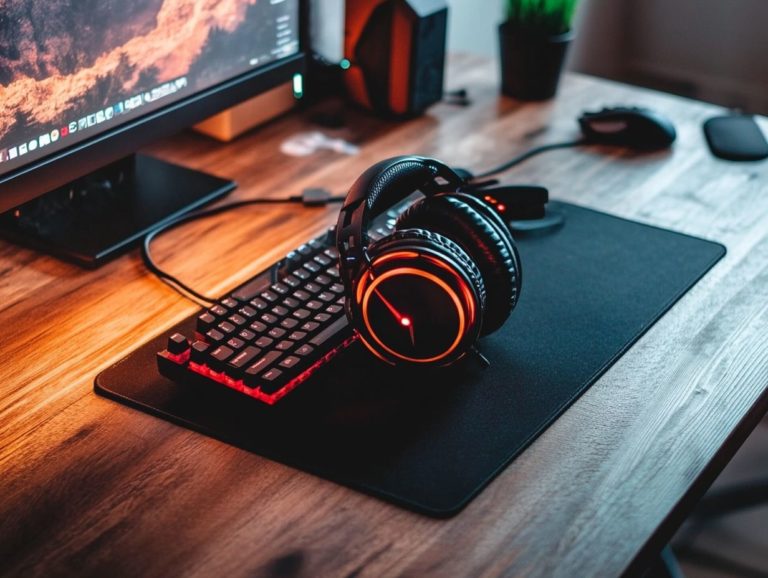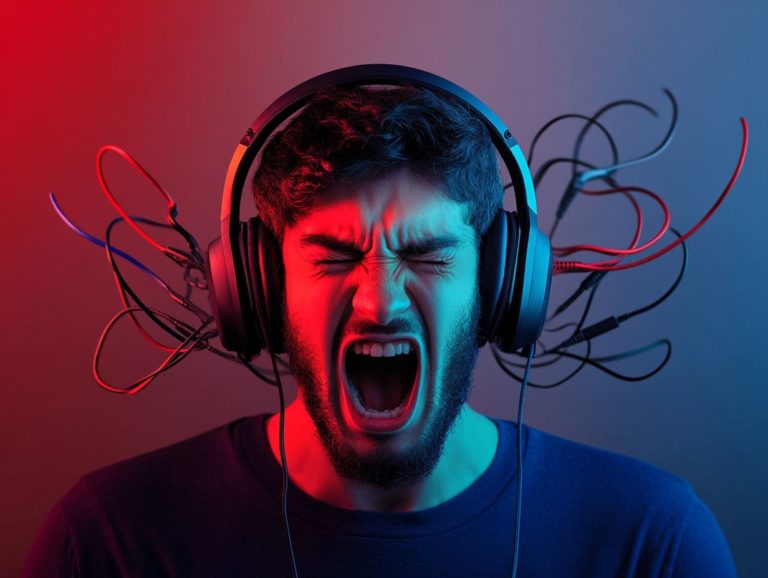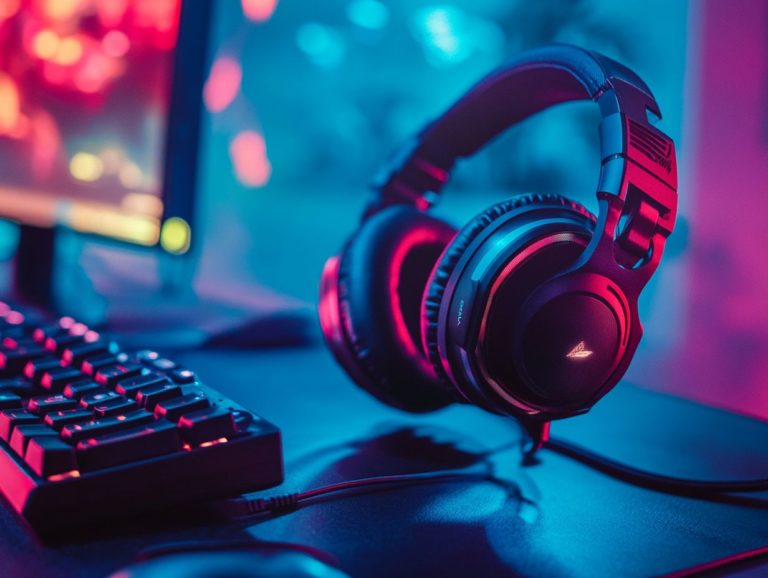how to extend the lifespan of your gaming headset
Gaming headsets are vital for an immersive experience, yet their longevity can often catch players off guard. Grasping the elements that impact their lifespan can profoundly enhance your gaming sessions.
This article delves into the key factors that influence headset durability, offers practical care and maintenance tips, and presents common troubleshooting solutions.
Whether you’re contemplating upgrades or searching for ways to extend your headset’s life, this guide will equip you with the knowledge to keep your gear in peak condition!
Contents
- Key Takeaways:
- Understanding the Lifespan of Gaming Headsets
- Proper Care and Maintenance
- Common Issues and How to Fix Them
- Upgrading and Replacing Parts
- Alternative Options for Extending Lifespan
- Frequently Asked Questions
- How can I extend the lifespan of my gaming headset?
- Can I use my gaming headset while charging?
- How often should I replace the ear cushions on my gaming headset?
- Can I use my gaming headset with multiple devices?
- How can I prevent my headset from getting tangled?
- What should I do if my gaming headset stops working?
Key Takeaways:
- Regular cleaning and proper storage extend headset life.
- Know common issues and how to troubleshoot them.
- Consider upgrades or replacements to keep your headset performing well.
- Use protective accessories to prevent wear and tear.
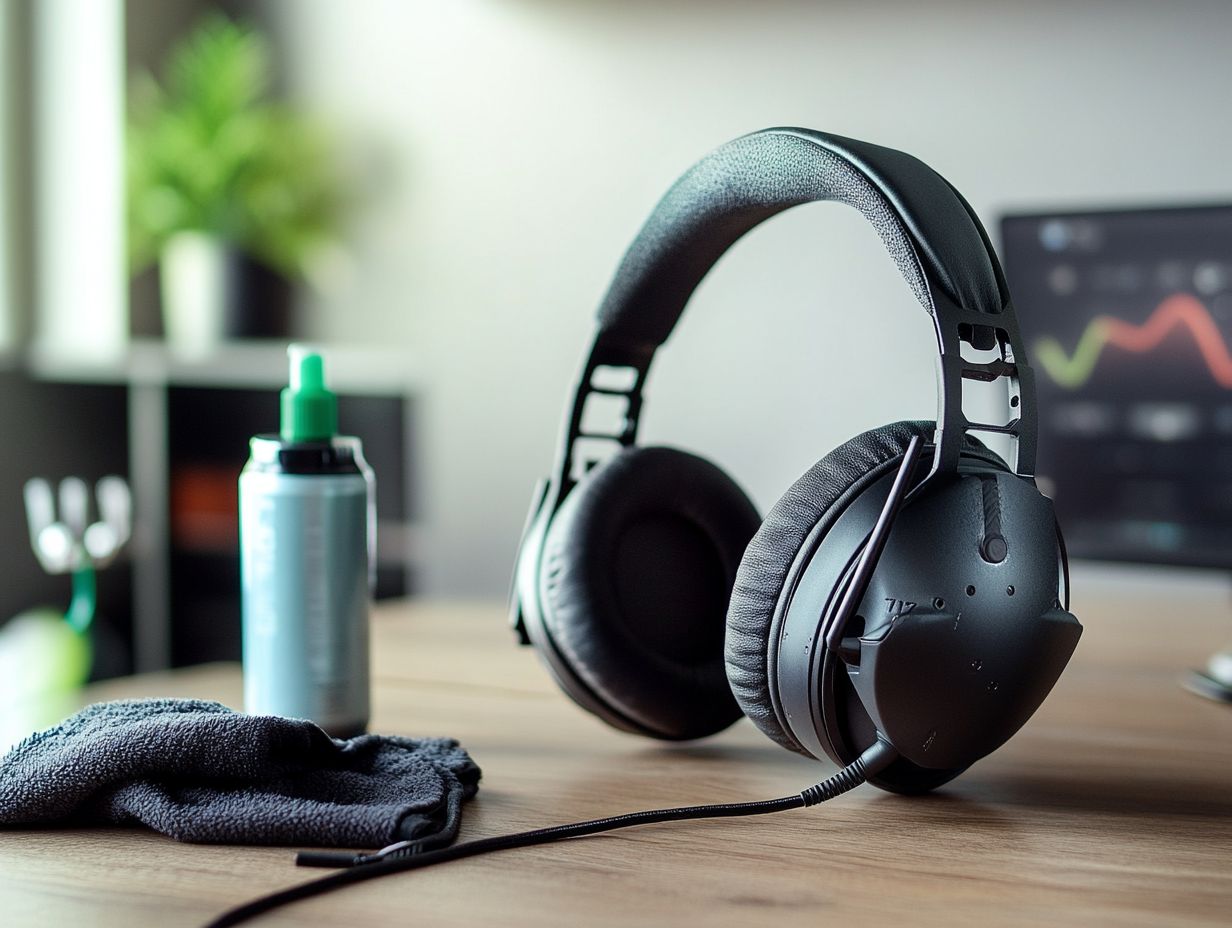
Understanding the Lifespan of Gaming Headsets
The lifespan of gaming headsets, such as the HyperX Cloud III, can greatly vary depending on factors like build quality, usage habits, and environmental conditions. Understanding these elements is vital for you as a gamer aiming to maximize your investment in top-notch audio solutions.
It’s crucial to understand how audio clarity, comfort, and durability affect your headset, especially in the fast-paced world of gaming technology.
Factors that Affect Lifespan
Several key factors influence the lifespan of your gaming headsets, including the materials used in their construction think aluminum frames and neodymium magnets. How regularly you maintain and clean them also plays a significant role.
These materials are selected not just for their sleek look but also for their durability against the rigors of extended use. Even top-tier components can wear down over time if they re not cared for properly.
Cleanliness is crucial; dirt, dust, and skin oils can build up in the ear cushions and audio components. Make it a habit to wipe down the exterior and use a soft brush to dislodge any debris to significantly enhance performance.
Storing your headset in a protective case is a smart move. This helps prevent physical damage and keeps it in peak condition for countless gaming sessions to come.
Proper Care and Maintenance
Taking proper care of your gaming headset is essential for longevity and preserving high sound quality. This involves routine actions like cleaning the ear pads, updating the firmware, and storing the headset in a protective pouch.
By implementing these simple yet effective practices, you can enhance your gaming experience and extend the life of your equipment.
Cleaning and Storage Tips

To keep your gaming headset in top-notch condition, effective cleaning and proper storage are crucial. Incorporating microfiber cloths and wipes into your routine allows you to effortlessly remove dirt and oil that gather on the ear cushions and hardware.
These soft materials strike the perfect balance between gentleness and effectiveness, ensuring delicate components are cleaned without scratching.
Store your headset in protective pouches when it s not in use. This simple step shields it from dust and prevents any physical damage.
Maintaining a stable environment steering clear of extreme temperatures adds an extra layer of protection for your equipment. Start these straightforward habits today for noticeable improvements!
Common Issues and How to Fix Them
Gaming headsets can face issues like audio glitches that can ruin your experience. These problems often arise from insufficient maintenance or improper handling.
It s essential to adopt a proactive approach to troubleshooting and resolving these challenges. By staying attentive to your headset’s care, you can significantly enhance its longevity and performance.
Troubleshooting Guide
When you encounter audio issues with your gaming headset, a systematic troubleshooting guide can be your best ally in identifying and resolving common problems effectively.
Start by ensuring that all connections are secure. Loose cables are often the culprits behind audio dropouts or distortion. Next, test your headset on different devices whether it s a smartphone or another gaming system to determine if the issue lies with the headset or the original device.
If sound issues persist, delve into common audio problems, such as a broken microphone or speaker. If you suspect worn parts, consider replacing components like ear cushions or cables to restore optimal performance.
By following these organized steps, you can get back to enjoying your gaming experience without frustration.
Upgrading and Replacing Parts
Upgrading and replacing parts of your gaming headset can elevate your audio experience to new heights.
This approach allows you to adapt seamlessly to the ever-evolving gaming technology landscape and your personal preferences, all without the hassle of investing in entirely new models.
When to Upgrade or Replace Parts
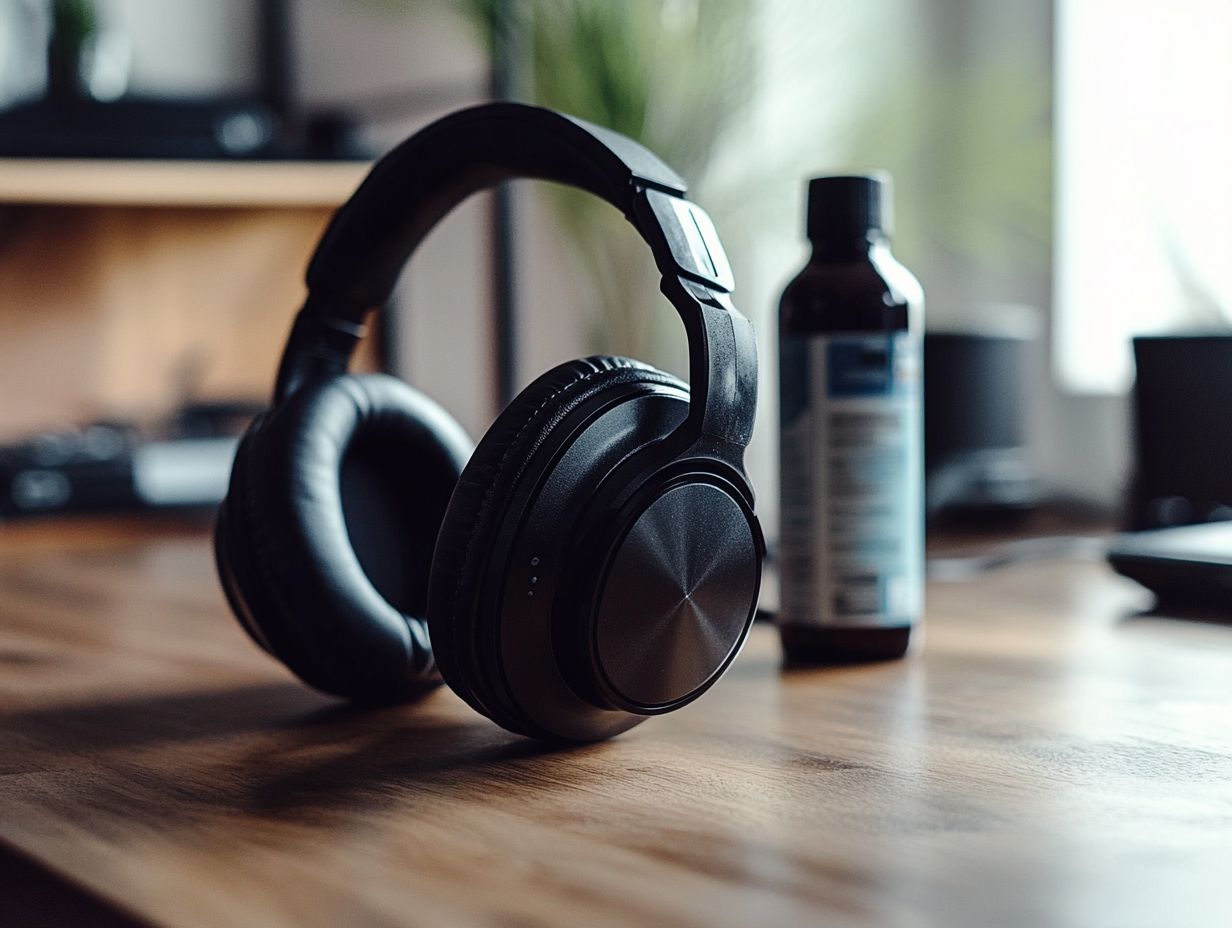
Identifying the right moment to upgrade or replace worn parts of your headset can significantly enhance your gaming performance and ensure an optimal audio experience. Regularly evaluating the condition and functionality of your headset is essential for maintaining that engaging gaming experience you crave.
Key criteria for your assessment should include:
- Examining the ear cushions for signs of wear, such as cracks, tears, or thinning material. These can dramatically impact comfort during marathon gaming sessions.
- Paying close attention to audio quality. Any distortion or imbalance in sound may signal that the drivers are failing.
- Recognizing that poor audio clarity can hinder your gameplay, making it difficult to pick up on in-game sounds that are crucial for your strategy.
By considering these factors diligently, you can ensure your gear is ready for any challenge in even the most intense gaming environments.
Alternative Options for Extending Lifespan
For gamers who wish to extend the lifespan of their headsets, using protective accessories and understanding budget constraints can be pivotal in safeguarding their investment, especially when knowing how to fix common gaming headset issues.
Using Protective Accessories
Using protective accessories for your gaming headset is a smart move that can significantly extend its lifespan while improving both performance and comfort.
In today s fast-paced gaming landscape, you have a multitude of options to keep your equipment in optimal condition, ensuring functionality and durability.
From padded ear covers to stylish cases, these accessories serve as an essential barrier against dirt, dust, and physical damage that could hinder sound quality and overall performance.
High-quality materials not only prevent scratches and dents, but they also contribute to a more comfortable experience during those marathon gaming sessions.
By investing in these protective solutions, you can fully immerse yourself in your virtual worlds, free from worry about wear and tear on your gear.
Choosing a Quality Headset
Choosing a quality headset from reputable brands is crucial for gamers who prioritize durability, sound experience, and comfort all while keeping an eye on budget constraints.
When hunting for the perfect gaming headset, consider several key attributes that can truly elevate your overall experience.
- Seek out headsets made from robust materials like high-grade plastic or metal components; these will withstand the demands of marathon gaming sessions.
- Sound quality is paramount, so features like surround sound are essential they ll immerse you in the game and make every moment more engaging.
Opting for reputable brands often means benefiting from a solid track record of excellent customer support and reliability. Striking the perfect balance between cost and quality allows you to enjoy premium features without breaking the bank, making your investment feel all the more worthwhile.
Frequently Asked Questions
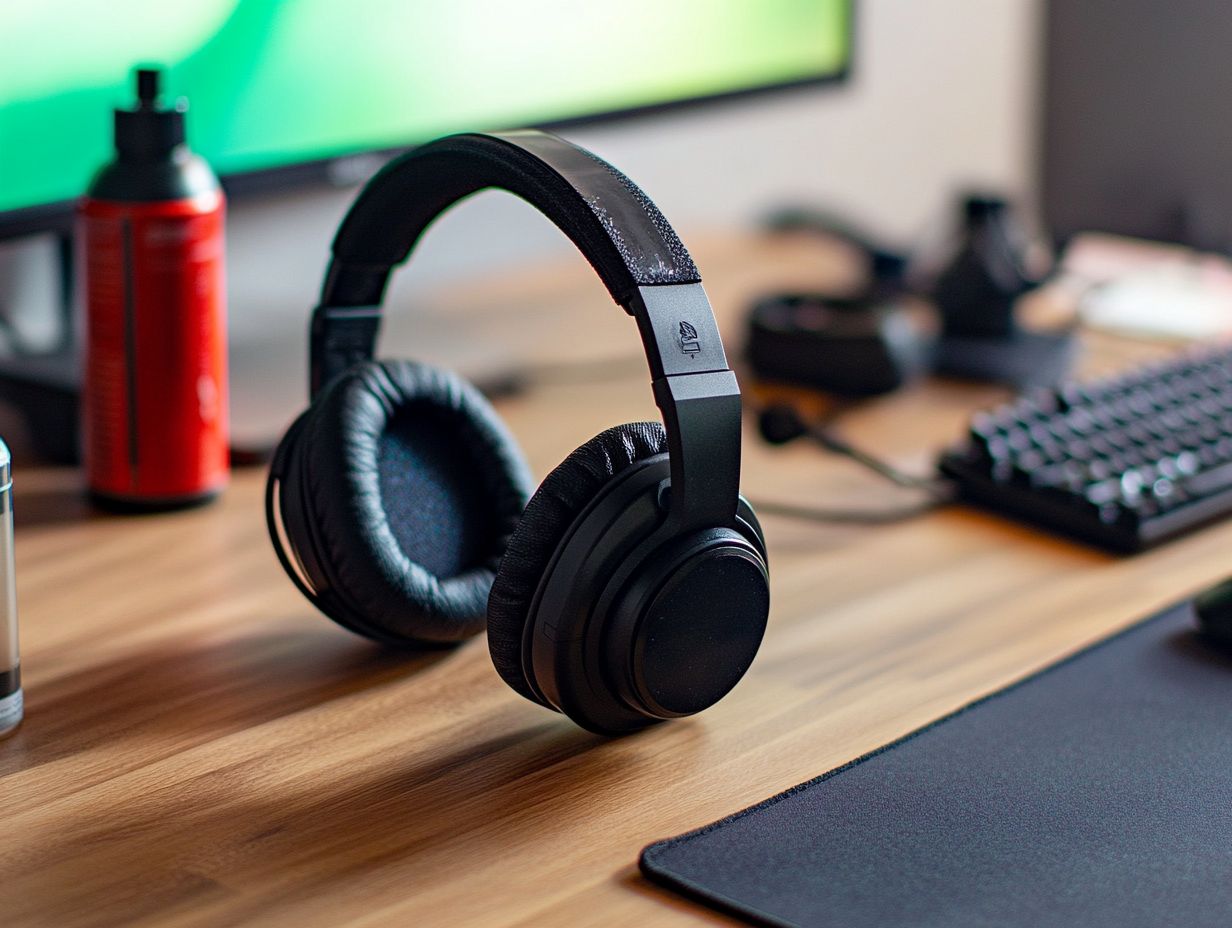
How can I extend the lifespan of my gaming headset?
To extend the lifespan of your gaming headset, follow these tips:
- Store your headset safely and dry when not in use.
- Clean your headset regularly, focusing on the ear cushions and microphone to keep dirt and germs away.
- Use a headset stand to avoid bending and pressure.
- Avoid yanking on the cables to prevent damage.
- Keep your headset away from extreme temperatures and water.
- Buy a good-quality headset for better durability.
Can I use my gaming headset while charging?
It’s not recommended to use your gaming headset while it s charging. This can strain the battery and affect its overall lifespan. Make sure to fully charge your headset for the best experience!
How often should I replace the ear cushions on my gaming headset?
The frequency of replacing ear cushions depends on the headset’s quality and usage. On average, replace them every 6-12 months to maintain hygiene and sound quality. If you notice wear or discomfort, replace them sooner.
Can I use my gaming headset with multiple devices?
Many gaming headsets work with multiple devices like computers, consoles, and mobile devices. However, check your headset s compatibility before using it with a different device to avoid potential damage.
How can I prevent my headset from getting tangled?
To prevent tangling, use a cable management tool or wrap the cables neatly around a headset stand when not in use. Always unplug the cables carefully to avoid pulling on them forcefully.
What should I do if my gaming headset stops working?
If your gaming headset suddenly stops working, try these troubleshooting steps:
- Check all cables and connections to ensure they are securely plugged in.
- Try using the headset with a different device to see if the issue is with the headset or the device.
- Restart your device and try using the headset again.
- If none of these steps work, reach out to the manufacturer for help or consider getting a replacement if it s still under warranty.



